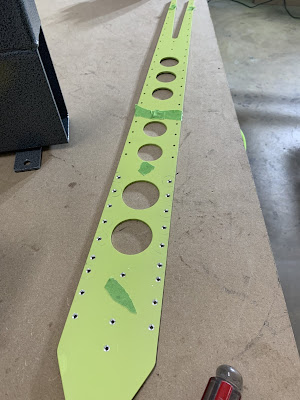The plans say to final drill the rudder trailing edges perpendicular to the chord line of the trailing edge, but countersink them parallel to the angle on the trailing edge. I used the Trailing Edge JIG from Cleveland tool and the drill press to drill perpendicular to the chord. This picture shows the scrap piece of the trailing edge in the Jig so I could practice and see how everything worked.
I then clekoed together the rudder so I could final drill the rudder skins using the trailing edge piece as a template.
After drilling a few of the holes I looked at the reverse side skins and noticed the holes where getting slightly enlarged. After thinking about it I decided to disassemble everything and use the #40 Reamer to final drill the skins and then deburr them.
I bought a speed deburring tool to make the deburring go faster, it works great on all the big pieces. Since the rudder skins are so thin I decided to deburr them by spinning the bit in my hand so not over do it.
After I finished deburring all the pieces I set to work prepping for paint. This was the same process that I used on the VS. Clean, acid etch and scuff, clean, let dry. Bill stopped by to help out with this.
This time I decided to Dimple before priming to see how that worked with the final assembly, I also went with the 2 part primer.
The 2 part primer was different. Part A was REALLY thick and chunky. I spent probably an hour on this day mixing and trying to break up the paint chunks and get everything to a smoother texture. I did add some distilled water, that seemed to help a ton. I wasn't able to get everything mixed to a perfect consistency, but it was close enough where I felt safe especially since I was going to pour it through a paint filter.
Got back into the paint booth! Before I primed I cleaned all the metal 1 last time with Rubbing Alcohol to remove and water residue or accidental hand marks. I try to not touch the parts after paint prep without gloves on, but my memory slips :)
The 2 part primer sprayed a little better and didn't have as much overspray it seemed. I definitely need work on my painting skills. My overlaps and speed aren't even and that shows in the final product. i also way overloaded the spraying tray and was getting overspray on pieces I wasn't trying to, also the pieces were so small and light the paint gun would blow them around and they would hit each other and mess up the finish. Lots of lessons learned this time around. 1. Mix the paint a few days before spraying to make sure its ready 2. Prime fewer pieces at a time 3. When spraying small pieces hold them in your hand and spray half, when it drys a bit spray the other half.
Started to assemble the Rudder! Started with the front spar and ribs. I really wanted my pneumatic squeezer to set the rivets, but I just can't get it to set the larger 1/8" rivets???! Another call to Cleveland Tools might be needed. Before I started to rivet I countersunk the trailing edge piece, I used the Jig again and it worked great.
Im very happy I realized I can use the Vise to hold the parts for riveting, BBBUUUUUTTTT I'm not happy that I bought the cheapest vise and on the bottom side it has strange parts of the cast metal that hit my parts and shipped the primer off! Well, yet another learning experience in the books I guess. I used the single part primer to touch up the metal. It looks bad, but its internal and the main purpose it corrosion protection so it works. I read on somewhere "You don't get the airplane you want, You get the airplane you built" this is definitely proving to be true!
The finished rear spar and ribs. I never looks like much for the amount of work it takes, but progress! Am i right?
Today I started to put the stiffeners on the rudder skin....Did not go well, Right from the start I riveted 3 rivets to the skin without the stiffener in place???! I was in way to big of a hurry and my mind was not with me I guess. This should have been a sign to pack it in for the day and head home, because it was not the last of my mistakes. this is what I should have did.
I even prepped those pictures for the blog before I did this instead. Notice these 3 rivets that are done, but the lack of stiffener :( I drilled these out and the holes were a little deformed, but I re-dimpled and Im gonna go with it. I might rebuild the Rudder in the future if I keep making mistakes.
This is where my second and third mistake happened. My back riveting plate is only so big, I got to one of the rivet that wasn't backed by the plate and hit it with the rivet gun. The EXTREMELY thin sheet metal of the rudder doesn't take kindly to that. Not only that, but I did it twice...Slow learner here. The edge of the back plate made a seam in the skin in both places. I gonna leave it for now, I think its something I work with high build primer in the future, or rebuild the rudder once my skills are better at the end of the project.
Finally got past all my struggles and finished one rudder skin.
I wanted to keep working, but it's Christmas Eve and I need to get ready for Church! Hopefully I can finish the Rudder this year.
Rudder 19.75 Hours






















































































